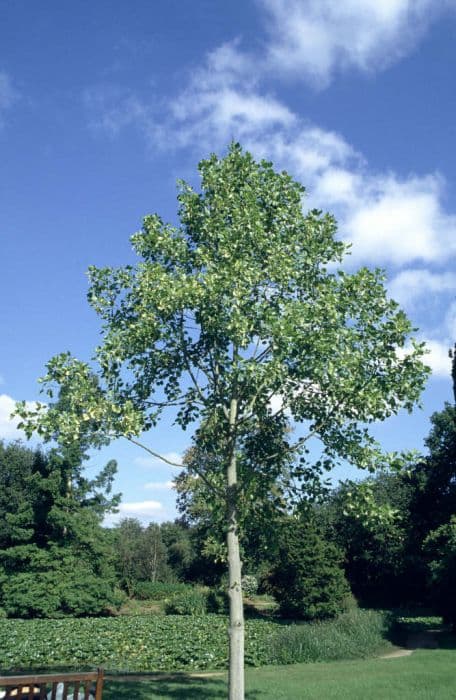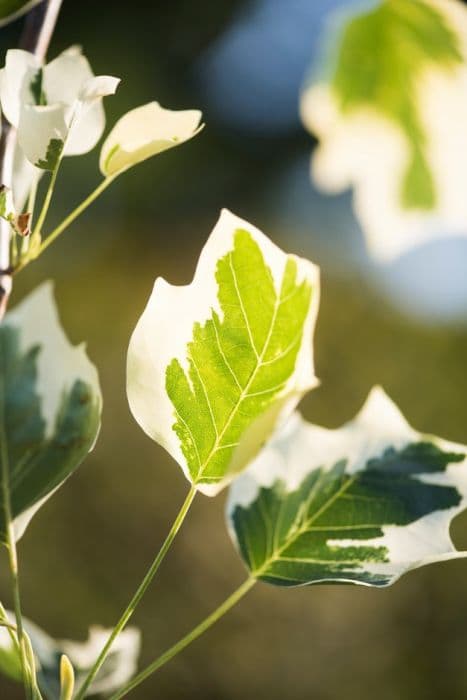Tulip tree Liriodendron tulipifera



ABOUT
Liriodendron tulipifera, commonly known as the Tulip Tree, is a deciduous tree that can grow up to 40 feet tall and up to 25 feet wide. It has a straight trunk that is typically free of branches for the first 50 to 80 feet, with a broad, pyramidal shape that becomes more open and spreading with age.
The leaves of Liriodendron tulipifera are four-lobed and resemble the shape of tulip flowers, measuring between 4 to 8 inches long and wide. They have a shiny, dark green color with a pale underside and turn golden yellow in the fall. The tree produces large, cup-shaped flowers that are greenish-yellow with orange markings and have a distinctive, tulip-like appearance. The flowers appear in late spring or early summer and are followed by large, cone-shaped fruit that is made up of many small, winged seeds.
The bark of Liriodendron tulipifera is gray-brown and develops shallow, furrowed ridges as the tree matures. The branches are stout and develop a spreading habit as the tree grows. Overall, the Tulip Tree has a stately appearance, with its tall, straight trunk, broad pyramidal shape, and large, showy flowers.
About this plant
 Names
NamesFamily
Magnoliaceae
Synonyms
Canary whitewood, Canoewood, Lyre tree, North American whitewood, Saddle tree, Tulip poplar, Western poplar, Whitewood, Yellow poplar, Tulip tree
Common names
Liriodendron fastigiatum, Liriodendron procera, Liriodendron truncatifolium, Tulipifera liriodendron
 Toxicity
ToxicityTo humans
The Liriodendron tulipifera plant is not known to be toxic to humans. However, its bark and leaves contain a bitter-tasting, milky sap that may cause irritation to the skin and mucous membranes.
To pets
The Liriodendron tulipifera plant is not typically considered toxic to most animals, including cats, dogs, and horses. However, the ingestion of large quantities of its leaves or seeds may cause gastrointestinal upset in some animals, such as livestock or wildlife. It is always best to consult with a veterinarian if you suspect your pet has ingested any part of this or any other plant.
 Characteristics
CharacteristicsLife cycle
Perennials
Foliage type
Deciduous
Color of leaves
Green, yellow in the fall
Flower color
Green, yellow, orange
Height
Up to 100 feet
Spread
Up to 40 feet
Plant type
Tree
Hardiness zones
3
Native area
North America
Benefits
 General Benefits
General BenefitsThe Liriodendron tulipifera is a tall tree with a broad canopy, providing shade during the summer months.
The Liriodendron tulipifera is prized for its striking flowers and attractive foliage, making it a popular ornamental tree.
The wood of the Liriodendron tulipifera is valuable for its strength, stability, and workability, and is commonly used for furniture, cabinets, and other woodworking projects.
The flowers of the Liriodendron tulipifera are a valuable source of nectar for bees, making it an important tree for honey production.
The Liriodendron tulipifera provides habitat for a variety of wildlife, including birds, squirrels, and other small animals.
The Liriodendron tulipifera helps to absorb and filter pollutants from the air and water, and can help to reduce erosion and improve soil quality. Medical Properties
Medical PropertiesLiriodendron tulipifera bark extract has been shown to have anti-inflammatory properties and may be useful in reducing inflammation in the body.
Liriodendron tulipifera bark also contains antioxidants that may help protect the body from damage caused by free radicals.
Some traditional uses of Liriodendron tulipifera bark include using it as a pain reliever, and it has been shown to have some analgesic effects in animal studies.
The root bark of Liriodendron tulipifera has been traditionally used as a digestive aid, although there is little scientific evidence to support this use.
It's important to note that Liriodendron tulipifera should not be used as a substitute for standard medical treatments, and anyone considering using it for medicinal purposes should speak with a healthcare professional first. Air-purifying Qualities
Air-purifying QualitiesLiriodendron tulipifera is known for its air purifying qualities. Its large leaves help to filter out pollutants, and its ability to absorb carbon dioxide helps to improve air quality.
 Other Uses
Other UsesThe wood of Liriodendron tulipifera is used for furniture making, particularly for high-quality veneers and cabinetry due to its attractive grain patterns.
The wood of Liriodendron tulipifera is also used to make musical instruments like guitars and drums.
Liriodendron tulipifera is used for construction materials like flooring and paneling, and for decorative uses like molding and trim.
The bark of Liriodendron tulipifera has been used historically to make paper, though it is not commonly used for this purpose today.
Interesting Facts
 Plant Symbolism
Plant SymbolismTulip tree is a symbol of beauty, love, and success. It is considered a sacred tree by some Native American tribes and has been used for various purposes throughout history. In the Victorian language of flowers, the tulip tree represents perfect love.
Tulip tree is also associated with success and achievement, perhaps due to its ability to grow tall and reach for the sky. It is said to inspire one to pursue their dreams and goals with determination and perseverance.
In some cultures, Tulip tree is believed to have healing properties and is used in various remedies. The tree's bark has been used to treat fevers and inflammation, while its leaves have been used to soothe sore throats and coughs.
 Water
WaterTulip tree prefers well-drained soil that is consistently moist but not waterlogged. It should be watered deeply once a week, and more often during hot and dry weather.
 Light
LightTulip tree grows best in full sun, but can tolerate some shade. It requires at least six hours of direct sunlight per day to thrive.
 Temperature
TemperatureTulip tree is hardy in USDA zones 4 to 9, and can tolerate temperatures down to -20°F. It prefers mild temperatures between 60-80°F, but can also tolerate high heat and humidity.
 Pruning
PruningPruning is usually not required for Liriodendron tulipifera trees, but it may be necessary to remove damaged or dead branches, or to shape the tree. Pruning is best done in late winter or early spring before the tree begins to produce new growth. When pruning, it's important to make clean cuts with sharp tools to prevent damage to the tree. Diseased branches should be pruned back to healthy wood, and any crossed branches or those growing in the wrong direction should be removed.
 Soil
SoilLiriodendron tulipifera, commonly known as the tulip tree, prefers well-draining soil with a slightly acidic to neutral pH level between 6.0 and 7.5.
 Humidity & Misting
Humidity & MistingThe best humidity level for Liriodendron tulipifera is moderate to high, between 50% and 70%. To maintain proper soil moisture and humidity levels, it is recommended to mulch around the base of the tree with organic materials and water deeply and regularly, especially during periods of drought.
 Suitable locations
Suitable locationsIndoor
Not growing
Outdoor
All year round
Hardiness zone
USDA 4 - 10
 Life cycle
Life cycleThe tree begins its life as a small sapling, typically reaching a height of 2-3 feet within the first year of growth. As it continues to grow, it will develop a single, straight trunk that can reach up to 6 feet in circumference and over 100 feet in height, with a crown spread of up to 50 feet.
During the spring, the tree will produce large, showy flowers that are yellow-green in color, with orange markings on the inside, which resemble tulips, hence the common name Tulip Tree. The flowers are followed by the production of fruit, which are cone-shaped and about 2 inches long. The fruit will mature and release winged seeds during the fall.
As the tree continues to age, it will develop a deeply furrowed, gray-brown bark, which provides a protective layer for the tree's vascular system. In the fall, the leaves will turn yellow before dropping, and the tree will enter a period of dormancy for the winter. Propogation
PropogationPropogation time
Fall, spring, summer
Seeds:
The best time to plant Liriodendron tulipifera seeds is in the fall, as the seeds require a cold stratification period before they will germinate. Soak the seeds in water for 24 hours before planting them 1 inch deep in a well-draining soil mix. Keep the soil moist and warm (around 70-75°F) and the seeds should germinate in 30-60 days.
Cuttings:
Softwood cuttings can be taken in late spring or early summer and should be around 6 inches long. Dip the cuttings in rooting hormone and plant them in a pot filled with a mix of perlite and peat moss. Cover the pot with a plastic bag to increase humidity and keep the soil moist. Once roots have developed, the cuttings can be transplanted into larger containers.
Grafting:
Liriodendron tulipifera can also be propagated through grafting, which involves taking a scion (a small piece of stem with a few buds) from a desirable cultivar and attaching it to the rootstock of a different tree. This method is typically done by experienced horticulturists and is used to preserve desirable traits of a cultivar.
 Pests
PestsScale insects, Aphid, Japanese beetle, Caterpillar
 Diseases
DiseasesVerticillium wilt, Powdery mildew, Leaf spot, Canker








![Magnolia [Fairy Blush]](/_next/image?url=https%3A%2F%2Fplants-admin.emdemapps.com%2Fimages%2Fplants%2F%2Fimages%2F604b5a108e959.png&w=640&q=75)
